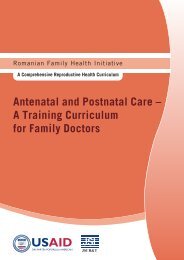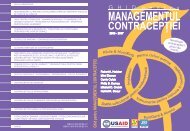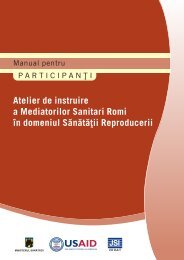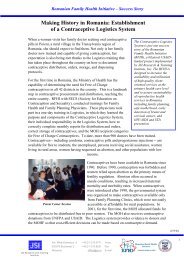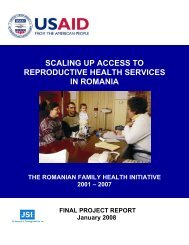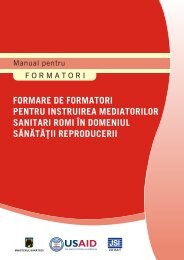Training of Roma Health Mediators in Reproductive Health
Training of Roma Health Mediators in Reproductive Health
Training of Roma Health Mediators in Reproductive Health
You also want an ePaper? Increase the reach of your titles
YUMPU automatically turns print PDFs into web optimized ePapers that Google loves.
Participant document<br />
FOLLOW-UP VISIT CHECKLIST<br />
Who can cont<strong>in</strong>ue us<strong>in</strong>g the SDM?<br />
This section <strong>of</strong> the checklist is designed to help providers determ<strong>in</strong>e whether the woman<br />
cont<strong>in</strong>ues to have cycles between 26 and 32 days.<br />
1. Have her menstrual cycles been between 26 and 32 days?<br />
This question is designed to help the service provider determ<strong>in</strong>e if the woman cont<strong>in</strong>ues<br />
to have cycles with<strong>in</strong> the recommended range for SDM users. Check the woman’s<br />
calendar to see if she has had any cycles shorter than 26 days or longer than 32 days. All<br />
women will have some variability with their menstrual cycles. If she has had only one<br />
cycle out <strong>of</strong> the 26 to 32 day range, <strong>in</strong>form her that she may still use the method.<br />
However, she should be careful and pay close attention to the length <strong>of</strong> her cycle. If the<br />
woman has more than one cycle out <strong>of</strong> the 26 to 32 day range per year, recommend that<br />
she considers another method.<br />
Recommended Questions:<br />
- Was your last period a normal period for you?<br />
- Has your period ever started before plac<strong>in</strong>g the r<strong>in</strong>g on the dark brown<br />
bead?<br />
- Have you ever put the r<strong>in</strong>g on the last brown bead and not gotten your<br />
period by the next day?<br />
- Have you had any bleed<strong>in</strong>g <strong>in</strong> between your periods?<br />
In case <strong>of</strong> m<strong>in</strong>or spott<strong>in</strong>g, <strong>in</strong>form the woman that this is a normal sign <strong>of</strong> impend<strong>in</strong>g<br />
ovulation, rather than a sign <strong>of</strong> a health problem. Otherwise counsel her accord<strong>in</strong>g to<br />
service delivery guidel<strong>in</strong>es or refer her for an assessment for unusual vag<strong>in</strong>al bleed<strong>in</strong>g.<br />
2. Was her most recent cycle still between 26 and 32 days?<br />
This question is designed to rem<strong>in</strong>d the provider to calculate the user’s cycle length aga<strong>in</strong><br />
to ensure that it is still with<strong>in</strong> the 26 to 32 day range. It is recommended that the provider<br />
use the calendar to calculate her cycle length by mark<strong>in</strong>g the first day <strong>of</strong> her most recent<br />
period on the calendar and the day she expects her next period. The provider then counts<br />
the days to determ<strong>in</strong>e the woman’s cycle length.<br />
Recommended Questions:<br />
- When was the first day <strong>of</strong> your most recent period?<br />
- When you do expect your next period?<br />
Does the SDM still work for the couple?<br />
This section <strong>of</strong> the screen<strong>in</strong>g checklist is designed to identify and expla<strong>in</strong> issues related to<br />
the couple’s relationship and how to assess whether they are us<strong>in</strong>g the method<br />
effectively.<br />
3. Do both partners still want to avoid pregnancy at this time?<br />
This question is important to confirm that both partners still do not want a pregnancy and<br />
that both partners still agree to use the method.<br />
98<br />
RFHI <strong>Tra<strong>in</strong><strong>in</strong>g</strong> <strong>of</strong> RHMs <strong>in</strong> <strong>Reproductive</strong> <strong>Health</strong> Session 5: SDM



